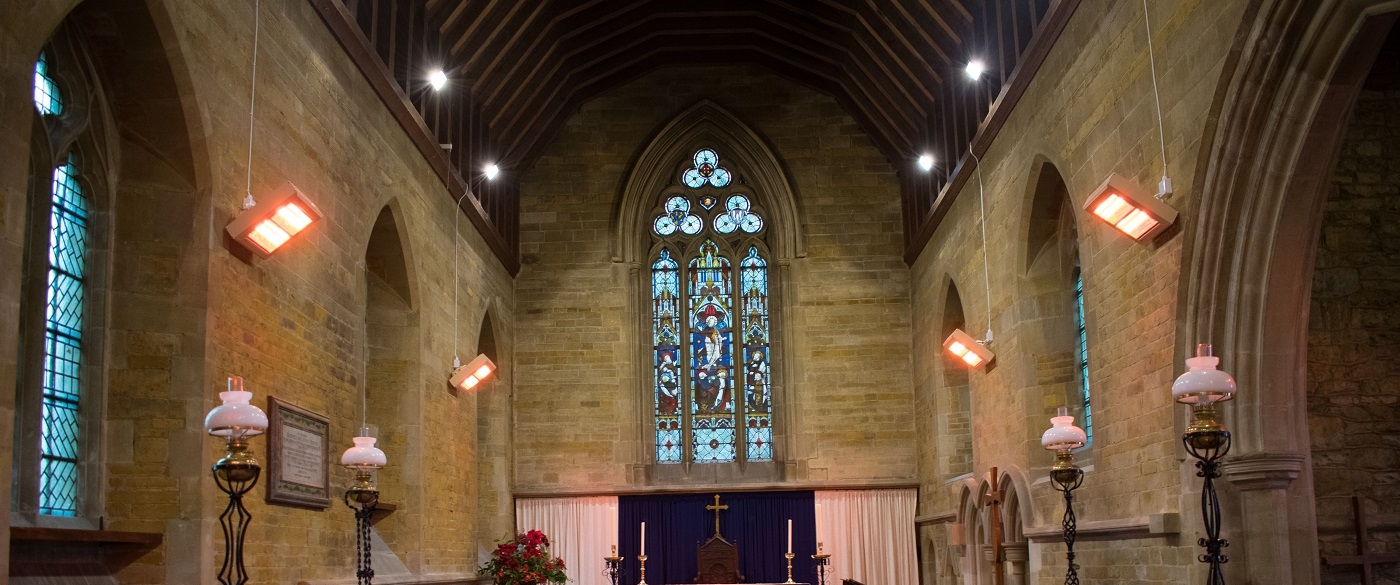
Church Heating
Traditional churches have the same characterises that always make conventional space heating systems costly and impractical. They are tall, uninsulated, sporadically used etc. Our two low-carbon approaches to keeping a congregation warm are highlighted below.
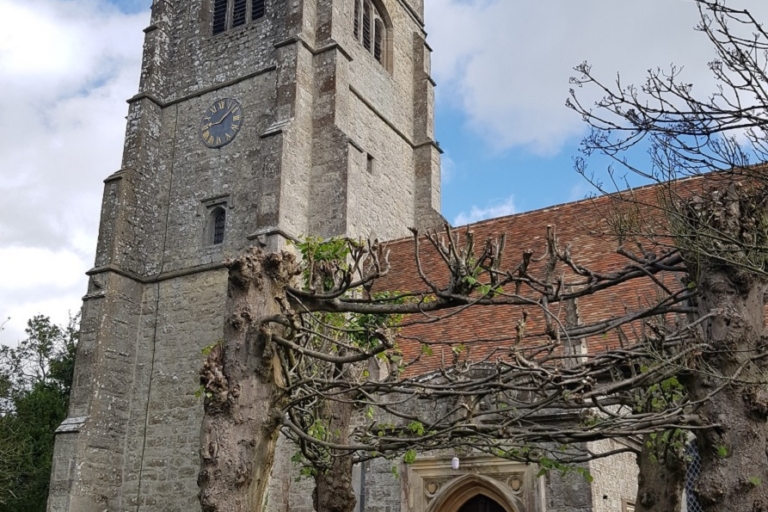
St James’ Church, Kent has under pew heating and radiant heaters installed
Church Heating
The efficient and cost-effective heating of churches presents a unique combination of considerations; both technical and aesthetic. A successful church heating system will be effective, economical to run and as visually unobtrusive as possible.
Traditional churches are tall buildings with a correspondingly large air volume to floor area ratio. They tend to be used intermittently and often have poor thermal properties. The combination of these factors means that conventional space heating systems are rarely practical. We are aware of churches heated by fan convector heaters, where the system needs to be energised several days before a service to provide an acceptable air temperature. This approach is wasteful and costly.
Pew Heating
BN Thermic has developed church heating systems that do not rely on building up and maintaining a body of warm air but rather heat people directly.
Where a church has fixed pews, we would always recommend our pew heaters. These unobtrusive heaters are fitted below the pew seats and provide gentle warmth to the congregation.
Click for our quick 3-step guide to measuring pews.
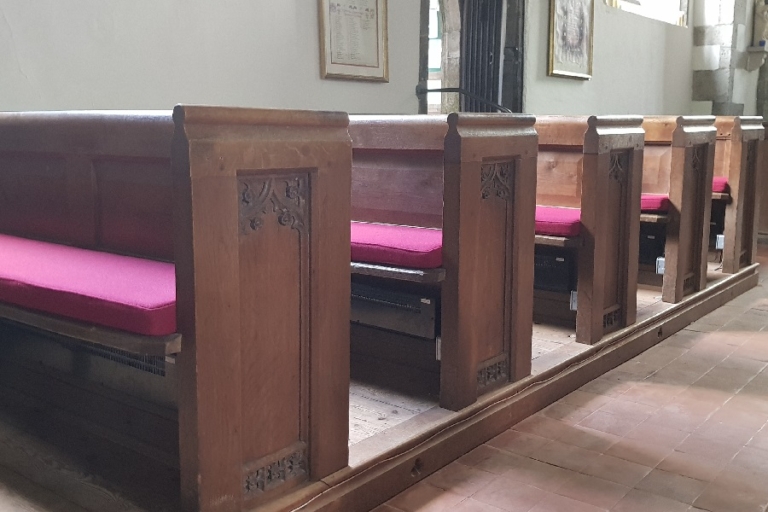
BN Thermic under pew heaters are the most unobtrusive means of church heating
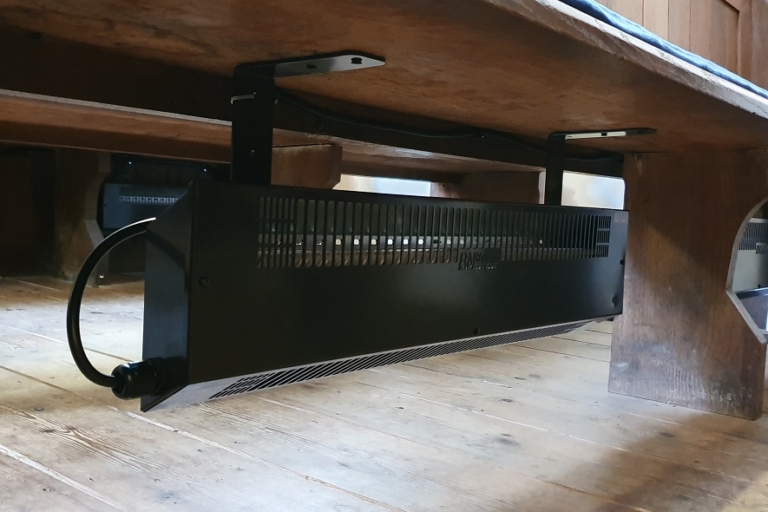
BN Thermic pew heaters can be easily mounted to back boards, floors and suspended under pews
Pew heaters should be switched on a few minutes before the start of a service and can be switched off immediately after the service has finished. The savings in terms of energy consumption are obvious and can be enhanced by switching off the heaters installed under unoccupied pews.
Energy saving is not the only consideration when selecting a pew church heating system. BN Thermic heaters have an all-steel construction, for many years of trouble-free service, and high quality dark brown paint finish meaning that the heaters are almost invisible. Pew heaters are also silent and therefore will not detract from the congregation’s experience.
Radiant Church Heaters
There is a trend for churches to replace pews with chairs. This approach allows for a more flexible use of the space and allows a church to be used for a wider range of events. However, where there are no pews there can be no pew heaters.
Where a church has no fixed pews, BN Thermic recommends quartz halogen heaters. As is the case with pew heaters, a halogen heating system is not designed to build up and maintain a body of warm air but will heat people directly. Halogen heaters are fully effective church heating instantly thus preventing energy waste.
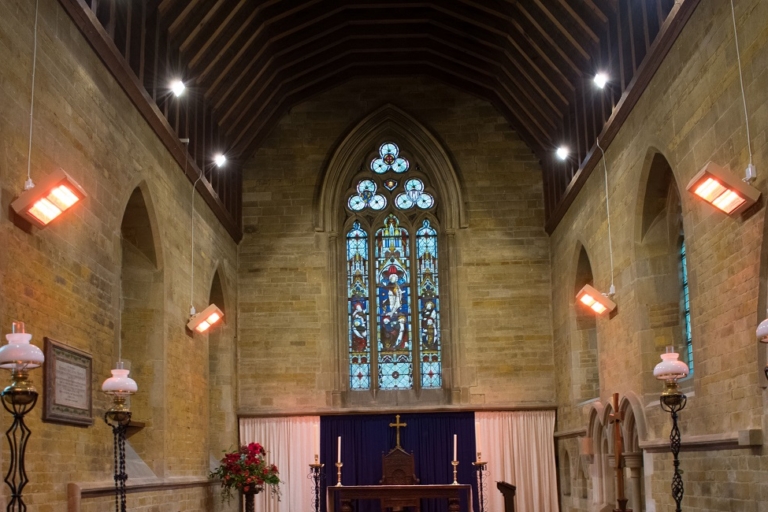
Quart halogen heaters provide instant comfort heat making them ideal for intermittently used buildings
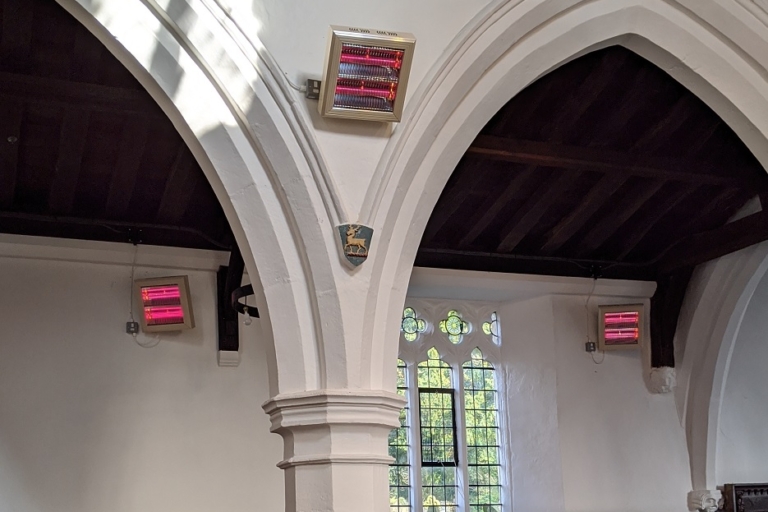
Zero glare magic lamps providing comfort heat in St. Peter’s Church, Pavenham
Halogen heaters are generally mounted between 3m and 5m above floor level and emit shortwave energy which is absorbed by solid bodies including the floor, furniture and, of course, people. Because halogen heaters operate in the shortwave part of the spectrum, some light output is inevitable. However, the introduction of BN Thermic’s Magic Lamp reduces the light intensity to a barely discernible glow.
Cost-Effective Church Heating Systems
Halogen church heating systems need to be carefully designed to ensure even coverage and optimum heat intensity. The engineers at BN Thermic are very experienced in designing church heating systems and are always on hand to assist.
When required, they will visit a church, carry out a survey and provide a bespoke heating proposal. This is 100% free, there is never a charge for this service. Contact us today to discuss your requirements.
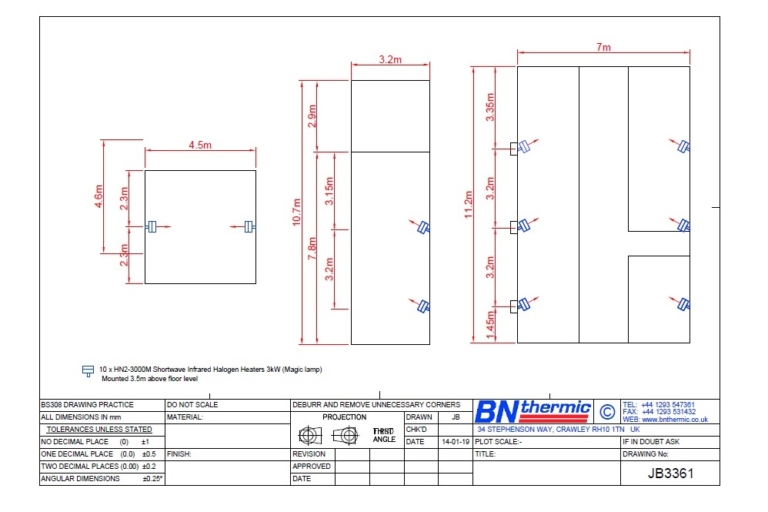
A bespoke heating design done by a BN Thermic engineer
BN Thermic offers a variety of radiant heaters some of which emit medium-wave and long-wave energy. These heaters do not emit any light whatsoever. However, their reduced radiant intensity means that they are not generally as effective as church heating. BN Thermic strongly recommends genuine shortwave halogen heaters for church heating.
-
Why is it so expensive to heat a church?
-
Space heating in a church can be very expensive. Space heating is the approach we generally use in our homes or offices i.e. we use heaters to create and maintain a body of warm air within a confined space. Space heating in a church tends to be expensive for a combination of reasons.
Churches have poor thermal properties with little or no insulation and often large expanses of single-glazed windows.
Churches tend to be tall buildings containing a correspondingly large volume of air that requires heating.
Churches are used intermittently – often only once a week. This means that a heating cycle will often have to start from a very low temperature when raising the air temperature to a comfortable level for a service. This issue is not a concern in more regularly used buildings such as homes or offices.
The solution to this problem is to use direct-acting heating systems such as pew heaters or quartz halogen heaters. These systems heat people directly without a requirement to build up and maintain a body of warm air.
-
How long does it take to warm a church?
-
When using a conventional boiler and radiators, we have known churches that have required several days of heating to reach an acceptable temperature. These were no doubt extreme examples but, again in our experience, warm-up periods of 24 hours are common.
BN Thermic recommends direct heating systems such as pew heaters or quartz halogen heaters. These systems heat people directly rather than the surrounding air, reducing the warm-up period to as little as ten to fifteen minutes. The resulting reduction in running costs is obvious.
-
What are the running costs using pew heaters?
-
A typical church pew is let’s say 2m long and is divided centrally by a seat support. This pew would require two 450W pew heaters. Assuming an electricity tariff of 15p/kWh, the running cost per pew, per hour would be 13.5p. To estimate the running cost for the entire church, simply multiply this number by the total number of pews. Please remember that only occupied pews need to be heated. So, for services with a more limited congregation size, the running heating costs can be very much lower.
We are aware that there is a wide variety of pews both in style and size. If you would like BN Thermic to assist with pew heater selection and to calculate the running cost, please do not hesitate to call our experienced and friendly engineers.
-
What are the running costs using infrared heaters?
-
The answer to this question is fairly straightforward if we are installing quartz halogen heaters. A typical church nave 15m x 4m would require six 3kW quartz halogen heaters. Assuming an electricity tariff of 15p/kWh, the running heating costs to heat the nave would be £2.70 per hour.
It is our opinion that other forms of infrared heating such as longwave radiant heaters (sometimes known as far-infrared heaters) are rarely suitable for church heating.
For a successful installation, the correct selection and positioning of quartz halogen heaters is vital. If you would like BN Thermic to assist with heater selection and calculate the running cost, please do not hesitate to call our experienced and friendly engineers
-
What are the main advantages of infrared heaters?
-
Our answer relates to quartz halogen heaters. It is our opinion that other forms of infrared heating such as longwave radiant heaters (sometimes known as far-infrared heaters) are rarely suitable for church heating.
Infrared Quartz halogen heaters are directly acting in that they heat people directly rather than heating the surrounding air. This feature reduces pre-heating to a few minutes and significantly reduces running costs.
Quartz heaters are ideally suited to heating the open areas of a church such as the chancel, or churches that do not have fixed pews.
BN Thermic quartz halogen heaters have a smart compact design and are available in black or ivory. Selecting a heater colour best suited to its mounting position keeps visual impact to a minimum.
With direct-acting quartz halogen heaters, only occupied areas of the church need to be heated. So, for example, there may be circumstances when there is a need to heat the chancel but not the nave. Taking this approach will reduce heating costs still further.
Traditional quartz halogen heaters have a significant red glow which is generally unwelcome in churches. BN Thermic ‘Magic Lamp’ heaters tend to be preferred as they emit a soft pink glow with zero glare.
-
Are 'far-infrared' heaters good for heating churches?
-
Far-infrared or longwave radiant heaters are an excellent choice for many applications but, in our opinion, are rarely suitable for church heating.
This style of heating should be considered as an alternative to fan heating as a means of producing and maintaining a body of warm air. This space heating approach is unsuited to an application where heat losses are very high and building use is intermittent.
Claims are made that far-infrared heaters ‘heat people not air’ and can therefore be used as an alternative to quartz halogen heaters. However, it is our experience that the radiant effect from a longwave or far infrared is not intense enough or focused enough to provide direct heat in the way that a quartz halogen heater can.
BN Thermic supplies both longwave (far-infrared) heaters and shortwave quartz halogen heaters. Both have their place, but it is our opinion that when installing infrared heating in a church, quartz halogen heaters are the best choice.
-
Is electric heating very expensive compared to gas?
-
For some space heating applications, there may be a running cost saving to be gained by using gas heating systems. However, gas heating can realistically only provide conventional space heating. In an intermittently used and thermally inefficient church, the result would be long warm-up periods and high running costs.
Electric heating can provide a dramatic reduction in running costs. Pew heaters or infrared quartz halogen heaters heat people directly keeping the warm-up time to an absolute minimum.
-
Is infrared heating safe?
-
Yes! There are no detrimental effects from infrared heaters such as BN Thermic’s quartz halogen heaters.
-
Can we have infrared heating without any light output?
-
To enjoy the direct-acting effect and associated economy of a quartz halogen heater, some light output is unavoidable. However whereas traditional quartz halogen heaters emit a significant red glow, BN Thermic ‘Magic Lamp’ heaters emit a soft pink glow with zero glare. For church heating, we recommend quartz halogen heaters from our Magic Lamp range.
-
Is underfloor heating suitable for heating a church?
-
Generally speaking, we do not recommend underfloor heating in the church. This style of heating works best in a domestic context where it is relatively easy for a floor to be heated to around 25°C and, having reached that temperature to raise the air temperature to, say 20°C.
Both these objectives are difficult to achieve in a church.
Church floors typically consist of thick flagstones or tiles and are not normally insulated. They therefore represent a huge thermal mass that will absorb energy from the underfloor heating extending warm-up time significantly.
If and when the floor reaches the desired temperature, it is highly unlikely that the kW output from the floor would be sufficient to maintain an acceptable air temperature or that the radiant effect from the floor would be sufficiently intense to provide adequate direct heating.
-
Can we use portable heaters to heat a church?
-
The use of portable heaters is not recommended as a permanent church heating solution. Two types of portable heaters might be considered.
Portable fan heaters are sometimes used in an attempt to heat the air within a church. This approach is likely to result in very high running costs as the heaters will have to produce sufficient kW output to offset heat losses from an inherently thermally inefficient building with a high percentage of their output being absorbed by the fabric of the building. It should also be noted that fan heaters are noisy and generally have to be switched off during a service.
Correctly selected and positioned portable quartz halogen heaters are more likely to be successful as they can provide direct targeted heat for specific areas. However please be aware that a quartz halogen heater’s lamp operates at a very high temperature and represents a genuine safety risk when a heater has trailing power cables and questionable stability.
BN Thermic always recommends fixed and hard-wired heaters.
Church Heating Case Studies
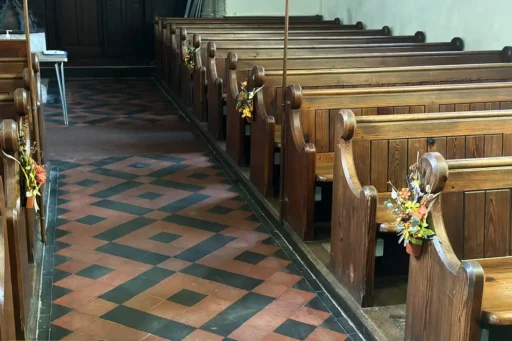
Pew Heaters and Zero Glare Radiant Heaters Installed at St Mary’s Church in Kennington, Ashford
Project Type: Church Heating
Location: Ashford
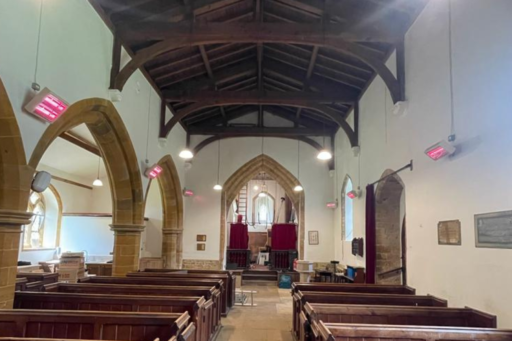
Zero Glare Quartz Halogen Heaters Installed in St Michael & All Angels Church in Creaton, Northampton
Project Type: Church Heating
Location: Northampton
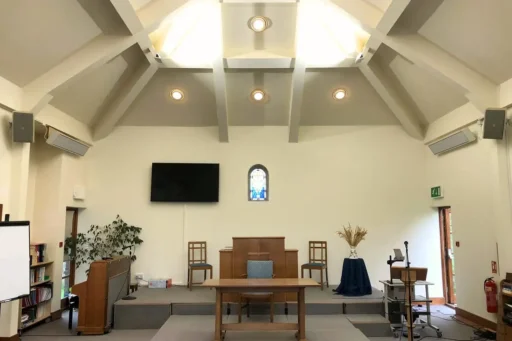
Longwave Radiant Cassettes Installed at Iden Green Congregational Church in Cranbrook, Kent
Project Type: Church Heating
Location: Kent